Bull Temple at Basavanagudi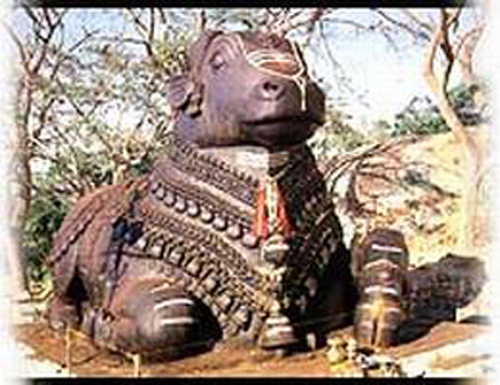
A
temple built in the Dravidian style by Kempe Gowda, founder
of Bangalore, it has a monolithic bull, made of gray granite
which is 4.5 mts high and 6.5 mts long. The Nandi bull
is revered as the 'vahana' (vehicle) of Lord Shiva. The
temple was supposedly built to appease a bull that devoured
all the groundnuts/peanuts grown in the area. The bull
stopped inflicting damage and the thankful farmers held
a Groundnut Fair (Kadalekai Parase) near the temple premises
which continues even to this day! The monolithic Nandi
bull is . One can also visit one of Kempe Gowda's four
towers situated near the temple.
Banashankari
Temple on Kanakapura Road
The
uniqueness of Sri Banashankari Amma Temple is that the
deity, Banashankari Amma is worshipped in Rahukala, an
inauspicious time according to Hindu belief. The area,
Banashankari is named after the goddess. Situated on the
busy Kanakapura Road, it is one of the most popular temples
of Bangalore. Devotees believe that by worshipping the
goddess Banashankari Amma in Rahukala one's hardships
and poverty will be removed.
Considering the large number of devotees who come to the
temple, the Government of Karnataka has taken it into
the purview of the Endowment Department. Though the temple
is opened to devotees everyday, Tuesdays, Fridays and
Sundays are special days when thousands of devotees throng
to the temple from dawn to dusk to offer special Pujas.
The goddess is worshipped with deeparaadhane by lighting
multiple oil lamps in half cut lemon peels with the pulp
removed.
The temple was built in 1915 by a devotee, Somanna Shetty
who installed a deity of Banashankari Amma brought all
the way from Badami in Bijapur district.
There are three big cultural ceremonies that are held
annually at the temple. The first one on September 13
every year celebrates the birthday of Banashankari Amma.
The temple also conducts the Dasara Festival in October
and the temple anniversary in Pushya Maasa, which falls
either in the end of December or in the first week of
January.
Kadu
Mallikarjunaswamy Temple at Malleshwaram
Built
in one of the oldest areas in Bangalore - Malleswaram,
the temple is on a hillock. As the legend goes, the temple
belonged to Chatrapati Shivaji's stepbrother Venkoji,
who came upon a 'shivalingam' in 1669 and consecrated
the temple around it.
Dodda
Ganesha Temple at Basavanagudi
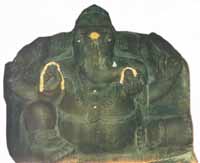 The
monolithic Ganesha is about 18 ft in height and 16 ft
in width. The God is also known as Shakthi Ganapathi or
Satya Ganapathi. People from all walks of life come here
to seek blessings. What makes this idol more attractive
to the devotees is, the different types of decorations
that are done during the week. The most famous is the
butter coating of the idol. More than 100 kgs of butter
is used for this purpose.
The
monolithic Ganesha is about 18 ft in height and 16 ft
in width. The God is also known as Shakthi Ganapathi or
Satya Ganapathi. People from all walks of life come here
to seek blessings. What makes this idol more attractive
to the devotees is, the different types of decorations
that are done during the week. The most famous is the
butter coating of the idol. More than 100 kgs of butter
is used for this purpose.
Shiva
Statue on Airport Road
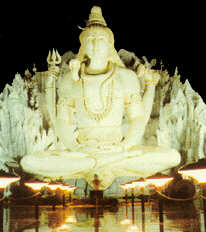 The
Shiva Temple, located on Airport Road, is seated Shiva
in the Himalayas, built in the year 1995. Shiva's idol
is a great crowd puller due to its grandeur, aesthetic
values, scenic beauty and majestic look. During festivals
it draws nearly four to five lakhs of devotees in a day.
Puja seva (service) is free of cost for everyoneIt boasts
of Awesome 65 feet high depiction of Lord Shiva seated
in Lotus position. It has the backdrop of Mount Kailash
the Lord's heavenly abode and the river Ganga flowing
from his matted locks as depicted in the mytholog
The
Shiva Temple, located on Airport Road, is seated Shiva
in the Himalayas, built in the year 1995. Shiva's idol
is a great crowd puller due to its grandeur, aesthetic
values, scenic beauty and majestic look. During festivals
it draws nearly four to five lakhs of devotees in a day.
Puja seva (service) is free of cost for everyoneIt boasts
of Awesome 65 feet high depiction of Lord Shiva seated
in Lotus position. It has the backdrop of Mount Kailash
the Lord's heavenly abode and the river Ganga flowing
from his matted locks as depicted in the mytholog
Gavi
Gangadareshwara Temple
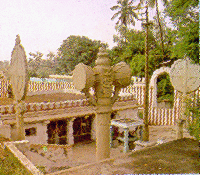 This
temple, also located near Basavanagudi, is well known
for its remarkable architecture. The Gavi Gangadhareshwara
temple is one of the oldest temples in Bangalore. Legend
has it that the cave temple dates back to the Tretha Yuga.
Kempegowda built two of the oldest temples in Bangalore:
the Bull temple and the Gavi Gangadareshwara Temple. The
temple, dedicated to Lord Shiva and Goddess Parvathi is
inside a natural cave in Gavipuram. Legend has it that
Kempegowda built this temple in gratitude after being
released from his five-year imprisonment by Rama Raya.
Devotees gather here on Makara Sankaranti day when it
is believed that at a particular moment in the evening
the sun's rays fall directly on the linga inside the cave,
passing between Nandi's horns.
This
temple, also located near Basavanagudi, is well known
for its remarkable architecture. The Gavi Gangadhareshwara
temple is one of the oldest temples in Bangalore. Legend
has it that the cave temple dates back to the Tretha Yuga.
Kempegowda built two of the oldest temples in Bangalore:
the Bull temple and the Gavi Gangadareshwara Temple. The
temple, dedicated to Lord Shiva and Goddess Parvathi is
inside a natural cave in Gavipuram. Legend has it that
Kempegowda built this temple in gratitude after being
released from his five-year imprisonment by Rama Raya.
Devotees gather here on Makara Sankaranti day when it
is believed that at a particular moment in the evening
the sun's rays fall directly on the linga inside the cave,
passing between Nandi's horns.
The
temple, which roughly covers an area of 300 ft by 200
ft, was renovated during the period of the local chieftain
Kempegowda, who is also known as the founder of Bangalore.
This dates the temple back to nearly 500 years. The 14-pillared
Mantap of the temple has elements of the Vijayanagar style
of architecture.
The
trishula dhamaruga (a drum attached to a trident), two
monolithic pillars called Suryapana and Chandrapana, the
towers on the rock outside the temple and a stone wall
on the adjoining Harihararaya Gudda were all said to be
installed during the Kempegowda period. The most interesting
feature of this temple is said to be the two paths inside
the cave. It is believed that while one path leads to
temple town Shivaganga in Tumkur district, another path
leads to Kashi. Apart from the idol of Eshwara with the
river Ganga springing from his head, there are also Durga
and Parvathi temples inside the cave. If one circumvents
these, one can see Sapthamathruke, Sridevi and Bhoodevi
idols.
Apart
from these idols, there is also the idol of Agnimurthi,
which comprises two heads, seven hands and three legs.
It is believed that worshipping this deity will cure one
of all eye defects. The priest points out that hundreds
visit the temple to find an answer to their problems.
Mondays see a huge turnout of devotees, he adds. Apart
from that, the Shudda Pournami day in February is also
a special day at the temple. A car festival is also held
during that time.
The
temple blends in beautifully with the entire area, which
also has a feel of old-world simplicity to it - a little
Bangalore away from the fancy and footloose City that
we all know of. The well-lit park that adjoins the temple,
with fountains et al, is probably the only “modern”
element in the vicinity.
The
temple is open from 7.30 am to 12.00 pm and again from
5 pm to 8.30 pm.
Dharmaraya
Temple
Located
in Nagarathpet, this temple has two exceptionally fine
images of Lord Krishna and Dharmaraja - hero of the epic
'Mahabharata'. The temple is also well known for the annual
Karaga festival.
The Karaga festival - a form of Shakti worship, is celebrated
during March/April of every year. The Karaga procession
starts from the Dharmaraya temple at Nagarthpet at about
2 am.
ISKCON
Temple on West of Chord Road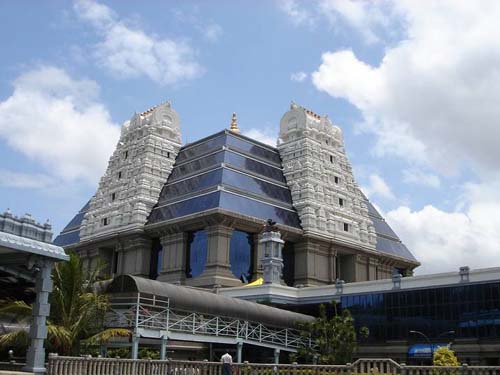
Sri
Radha Krishna temple and cultural complex, which is an
architectural masterpiece is set on a seven-acre hillock
called the 'Hare Krishna Hill'. This is ISKCON's
global project to commemorate the birth centennial of
its founder Sri Prabhupada. Built in the Neo-Classical
style, it combines traditional elements of temple architecture
with high-tech utilities. Ornamental arches and illuminated
water cascades lead to an elaborately decorated Rajagopuram.
There is a unique open air amphitheatre for concerts and
festivals.The four temple 'gopurams' are connected by
a stunning glazed glass canopy which forms the main 'Hari
Naam Kirtan' - a hall of 10,000 square feet. The hall
has wonderful ceiling paintings. There are also Vedic
museums and exhibit areas, a lecture hall with multiple
language translation system and landscaped gardens. The
main attraction is ISKCON Vedic Theatre, where a multimedia
Vedic film is shown.
Prasanna
Veeranjaneya Temple in Mahalaxmi Layout
The
uniqueness of the Prasanna Veeranjaneya temple, apart
from the 22-foot-high deity of Veeranjaneya, is its peaceful
atmosphere. The cool breeze and surrounding greenery,
coupled with an aura of mysticism, bring solace to devotees
visiting the temple.
Sugreeva
Venkateshwara Temple
Located
in Balepet area, this temple houses idols of Sugreeva
and Venkateshwara. The inner shrine of the temple has
an idol of Lord Venkateshwara placed on a pedestal. The
Sugreeva idol, which is about six feet in height and appears
like Hanuman. The long teeth on either side of the mouth
are the only thing which differentiates it from Hanuman.
Kanyakaparameshwari
Temple in KumaraPark
Apart
from the Goddess which is a popular among the devotees
in and around Malleshwaram, the Temple has a fascinating
feature - Marble Mandira, murals of holy places and Darpana
Mandira (Mirror Mandir) depicting Rishis, Bhagawada Gita
and Vasavi history
Venkataramanswamy
Temple
Is
a small temple with some interesting carvings, built by
Chikkadevaraj Wodeyar. There are figures of Brahma, Vishnu,
and Shiva on the walls and an idol of Venkatarama in the
sanctorum. After Lord Cornwall's assault, in 1791, the
original pillar had to be replaced as it was hit by a
cannon ball. Built in typical Dravidian style, this temple
has survived through the reign of Chikkadevaraj Wodeyar,
Sultan Haider Ali and Tipu Sultan.



